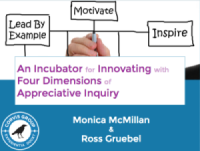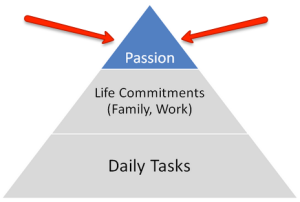
This past Friday, a colleague, Monica, and I co-presented at the Chesapeake Bay Organization Development Network’s annual conference on innovation in organizations. Our workshop was an incubator for innovation, featuring the Four-D Model of Appreciative Inquiry, titled An Incubator for Innovating with Four Dimensions of Appreciative Inquiry.
In the session, we introduced the Four-D Model (Discover, Dream, Design, Deliver) and walked participants through a creativity exercise to prime their thinking on innovation. Since many of us spend so much time and energy on small tasks such as doing laundry, attending a work meeting, and figuring out what’s for dinner; or on our bigger life commitments, such as family and career; it is often difficult to spend time thinking about our passions and dreams. Therefore, Monica and I created a space in the workshop for consultants and business leaders to take time and discover their passions while also taking action to reach their dreams.

Next, each participant identified their passions and dreams. Their passions being what they were eager to accomplish in their lives, or the driving forces that excite them. Focusing on a particular goal that they wanted to accomplish–we called this their “incubator idea”–we then asked them to share what they wanted to accomplish for themselves. Some identified career goals, while others identified more personal dreams.
After walking through some introductions on passions and ideas, participants then broke into pairs or small groups. Using the Innovator’s Handbook, which we created specifically for this workshop, each attendee had the opportunity to receive coaching, as well as offer support to others in the room. Using guiding questions in the handbook and the small-group coaching, each person could then identify the types of support that they need to reach their goal, their desired outcomes (including tangible and emotional measures of success), and could form an action plan. We encouraged participants to take at least one action in the room, such as calling a friend to set up a meeting, or emailing a prospective client to have lunch about partnering on a project. By the end of the session, each attendee had walked through the Four-D Model and identified an action plan to help move them forward over the next few days, weeks, or longer.
Below are the slides used during the session, along with the Innovator’s Handbook.
Now that you’ve heard an overview of this workshop, here are a few questions for you to consider:
- What inspires me most? What gives me energy?
- What is my dream goal?
- What are my strengths and accomplishments?
- What would it look like to achieve my dream goal?
- What support do I need, and who can help me?
- What can I do right now to take a step towards my dream?
References
Appreciative Inquiry Commons (n.d.). Cleveland, OH: Case Western Reserve University. Retrieved from: http://appreciativeinquiry.case.edu/default.cfm.
Cooperrider, D.L. & Whitney, D (2001) A positive revolution in change. In Cooperrider, D. L. Sorenson, P., Whitney, D. & Yeager, T. (eds.) Appreciative Inquiry: An Emerging Direction for Organization Development (9-29). Champaign, IL: Stipes.
Daft, R. (2011). The Leadership Experience (5th ed.). Mason, OH: South-Western Cengage Learning.
Page, S. (2007). The Difference: How the Power of Diversity Creates Better Groups, Firms, Schools, and Societies.Princeton, NJ: Princetone University Press.
Watkins, J., & Mohr, B. (2001). Appreciative Inquiry: Change at the Speed of Imagination. San Francisco, CA: Jossey-Bass/Pfeiffer.